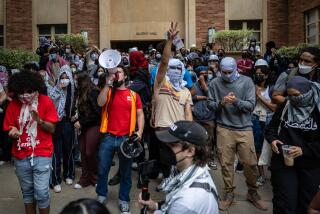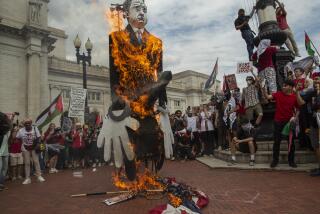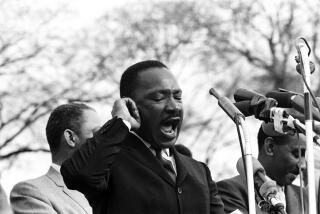Not All Marchers Will Follow the Leader : Activism: Members of O.C.’s black community to join ranks but distance themselves from Nation of Islam official.
FULLERTON — In predominantly white Orange County, John Reid, an African American, sometimes feels like he is one in a million. But come a plane trip this weekend, the 53-year-old Navy veteran from Cypress plans to join ranks with what organizers hope will be 1 million other African-American men in an unprecedented march on the nation’s capital.
Ticking off a list a problems in some black communities, including high crime rates, too many single-family households and disproportionately large numbers of young men in the prison system, Reid concludes: “We can’t sit back anymore. We have got to take responsibility.”
With months of impetus from controversial Nation of Islam leader Louis Farrakhan, the “Million Man March” on Monday is meant to unify African American men and protest what is considered an oppressive Establishment.
But the march’s appeal and message has steadily broadened in recent months, and is now embraced by the Rev. Jesse Jackson, Washington Mayor Marion Barry and poet Maya Angelou.
In Orange County, where blacks make up 2% of the 2.6 million residents, the march has attracted at least a handful of people, though reliable estimates are not available. A rally for those who can’t travel to Washington is slated for Monday in Costa Mesa.
“It’s a very exciting moment,” said Noah Kikwama Kimbwala , a 21-year-old senior at Cal State Fullerton, who plans to march in Washington. “Not very long ago African Americans were portrayed as invisible men, but now because of all the publicity and attention we are receiving before the march, we will be visible as men.”
Participants have little idea how many people the two-mile march from the Capitol to the Lincoln Memorial will draw. But, they say, it’s the message--not the march itself--that’s important anyway.
“The march itself is insignificant compared to the meaning of what we will be trying to implement when we get back--strengthen communication, build stronger communities, and increase black male involvement in the family,” said Kimbwala, who is majoring in Afro-ethnic studies and sociology.
*
The march is not without its critics, in large part because of Farrakhan’s major organizing role. The fiery speaker has long been a lightning rod for criticism stemming from his disparaging remarks about “white devils,” Jews and homosexuals.
“I don’t support Louis Farrakhan and some of the things he says,” said Randall Jordan, publisher of the monthly Black Orange, which covers Orange County’s black community. “I don’t believe that the white man is the devil. If we fall into that trap, we would be just as guilty as the white man has been.”
Jordan also questioned the purpose of the march, whose themes seem to span everything from religious to political activism. Jordan is equally puzzled by Farrakhan’s reference to the event as a “day of atonement and reconciliation.”
“I think it’s good for black men to come together,” he said. “But I’m just not clear what the objectives are.”
Others complain the march wrongly excludes women, even though in a late concession Angelou and civil rights icon Rosa Parks were added to the list of speakers. JoAnna Koskinen, an African American student at Cal State Fullerton, said marchers would do better to stay at home if they want to help women and their community.
“While those guys are off trying to find themselves,” wrote Koskinen in a recent column in a campus newspaper, “their women can continue doing what they’ve been doing all along--taking care of business.”
But participants say the need for African American men to pull together outweighs the criticisms.
*
Kimbwala argues that the mobilization of African American men will indeed strengthen their relationships with their women and their families.
“African American males have not done their part [for the family],” said Kimbwala. “That’s why we are beginning with atonement.”
And Reid, who said he too is troubled by some of Farrakhan’s remarks, said he believes only good can come of the march. He said he hopes the image of a large gathering of black men would foster discussion of racial attitudes, though he wonders if whites will find the march intimidating.
“Whites always seem to be threatened by black men, and it doesn’t have to be a large group,” said Reid, who oversees a university program to make sure ethnic athletes graduate. “With this many black men coming together, they might think it’s the holocaust.”
He added: “I’ve been slammed up against a police car for nothing more than being black,” said Reid. “And I don’t know a black man who hasn’t been. . . . Most whites just don’t realize this.”
“Whites need to look through the fear,” added Reid. “We want to belong to the same family, the human race. We want to be treated fairly. . . . You know what we want? The same things whites want.”
Still, marchers regard black self-empowerment as the fundamental point. Charles Moore, an admissions director at Cal State Fullerton, said he is heading to Washington to urge blacks to form their own schools, banks and businesses.
“We need to own and control our own,” said Moore, 40, who also owns a record store in Los Angeles.
For Moore, who was barely a teen-ager during the height of the civil rights movement, the march also presents an opportunity to take action today.
“There have been very few chances for me to coalesce with 200 or 300 black men,” said Moore. “I will feel a strength I’ve never felt.”
More to Read
Sign up for Essential California
The most important California stories and recommendations in your inbox every morning.
You may occasionally receive promotional content from the Los Angeles Times.










